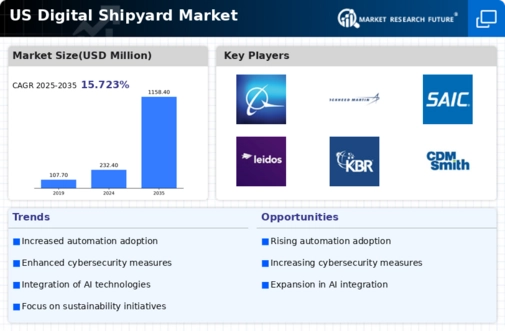Regulatory Support
The US digital shipyard market benefits from supportive regulatory frameworks that encourage modernization and innovation. Government initiatives aimed at enhancing maritime capabilities and competitiveness have led to increased funding for research and development in shipbuilding technologies. For example, the Department of Defense has allocated significant resources to improve naval shipbuilding processes, which indirectly supports the broader shipyard sector. This regulatory environment fosters collaboration between public and private sectors, facilitating the adoption of digital technologies. As regulations evolve to support digital transformation, the US digital shipyard market is poised for substantial growth.
Technological Advancements
The US digital shipyard market is experiencing a surge in technological advancements, particularly in automation and artificial intelligence. These innovations streamline operations, enhance productivity, and reduce costs. For instance, the integration of robotics in shipbuilding processes has shown to decrease labor costs by approximately 20%. Furthermore, the adoption of advanced simulation tools allows for better design and testing, leading to improved product quality. As shipyards increasingly embrace these technologies, they position themselves to meet the growing demand for efficient and high-quality vessels. The potential for enhanced operational efficiency through these advancements is likely to drive growth in the US digital shipyard market.
Focus on Workforce Development
The US digital shipyard market recognizes the importance of workforce development in adapting to new technologies. As digital tools and automation become more prevalent, there is a pressing need for skilled workers who can operate and maintain these systems. Shipyards are increasingly investing in training programs and partnerships with educational institutions to cultivate a workforce equipped with the necessary skills. This focus on workforce development not only addresses current labor shortages but also positions the industry for future growth. By ensuring a skilled workforce, the US digital shipyard market is likely to thrive in the coming years.
Enhanced Supply Chain Management
Effective supply chain management is becoming increasingly critical in the US digital shipyard market. The integration of digital tools allows shipyards to optimize their supply chains, ensuring timely delivery of materials and components. This optimization is essential for maintaining production schedules and reducing costs. For instance, the use of blockchain technology in supply chain processes has shown promise in enhancing transparency and traceability, which can lead to improved supplier relationships. As shipyards adopt these digital solutions, they are likely to experience increased operational efficiency, thereby driving growth in the US digital shipyard market.
Growing Demand for Customization
The US digital shipyard market is witnessing a growing demand for customized vessels tailored to specific client needs. This trend is driven by the increasing complexity of maritime operations and the need for specialized ships in various sectors, including defense, tourism, and cargo transport. Shipyards that leverage digital technologies can offer bespoke solutions more efficiently, thereby attracting a broader client base. According to industry reports, the market for customized vessels is expected to grow at a compound annual growth rate of 5% over the next five years. This demand for customization is likely to propel the US digital shipyard market forward.

















Leave a Comment